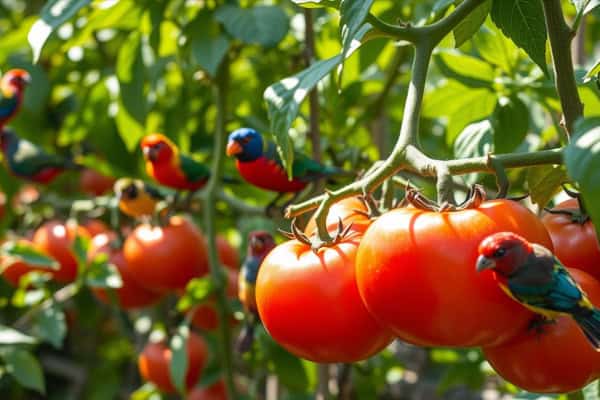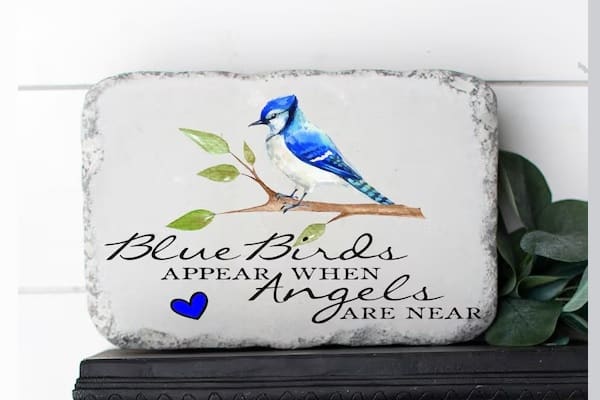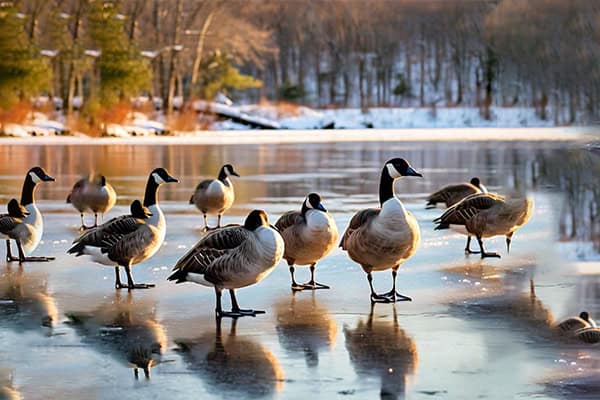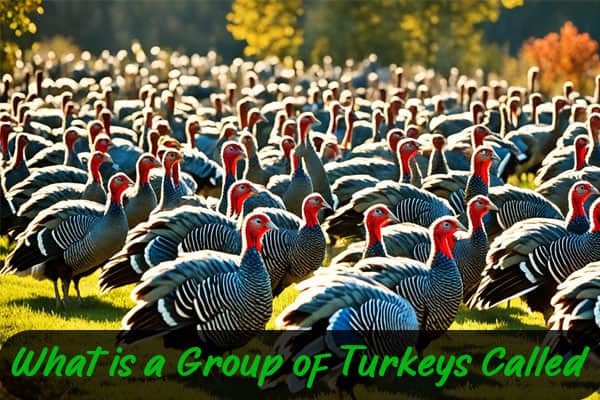Do Birds Eat at Night? Nocturnal Feeding Guide
Do you know some birds eat at night? Ever wonder why some birds are active at night while others sleep? This question leads us into the world of bird feeding patterns. Most birds, like us, are active during the day. But a few, called nocturnal birds, love the night.
Knowing about these patterns is key, especially as cities grow and take over their homes. In this guide, we’ll look into how and when birds eat. We’ll see how some birds can hunt in the dark.
By exploring nighttime feeding habits, we’ll learn more about bird adaptations. This knowledge is great for bird lovers and scientists. Let’s discover how different birds eat, day and night.
Understanding Bird Feeding Patterns
Bird feeding patterns show us how fascinating our feathered friends are. Many birds follow certain feeding times, especially at dawn and dusk. These times match their natural instincts and body clocks, helping them find food.
Some birds visit feeders up to 70 times a day. This shows how much they need to eat.
The Importance of Feeding Cycles
Feeding cycles are key to birds’ lives. Food is crucial for them to survive, especially in harsh seasons like winter. Over 133 bird species use garden feeders in winter, showing how vital they are.
Feeders help birds stay healthy in fall and winter. They provide important calories from bird seed when food is scarce.
Factors Influencing Feeding Times
Many things affect when and how birds eat. Weather can change their eating habits. For example, bad weather can make birds visit feeders less often.
It’s important to understand how these factors affect their eating habits and behavior.
| Factors Influencing Feeding | Effect on Bird Behavior |
|---|---|
| Weather Conditions | May disrupt feeding rhythms, decreasing frequency of visits |
| Temperature | Strongly influences feeding patterns, prompting behavior adjustments |
| Food Availability | Critical in determining feeding cycles, especially during seasonal changes |
| Human Activity | Encourages the presence of more birds in urban settings, affecting their feeding choices |
When Do Birds Eat? The Daily Schedule
Knowing when birds eat helps us understand their daily lives. They eat at different times because of daylight and seasons. Their eating times fall into three main periods: early morning, midday, and evening.
Early Morning Activity
Birds eat a lot in the early morning. This is when they fill up after a night without food. Cardinals and robins are often seen at feeders right after sunrise. They make up about 33% of all morning feeding.
This shows birds eat before it gets hot and busy. It’s their main time to eat.
Midday Feeding Trends
In the midday, bird activity drops a bit. Only 46.3% of feeding happens then. Smaller birds and young ones feed at night during this time because it’s less crowded.
This period is a bit quieter. But, birds still find ways to eat based on their surroundings.
Evening and Dusk Rituals
As the sun sets, birds start to eat again. This time makes up about 27% of their eating. They eat more to have energy for the cold nights, especially in fall and winter.
This shows how important daylight, temperature, and eating bird seed are to birds.
| Feeding Period | Percentage of Feeding Instances | Common Visitors |
|---|---|---|
| Early Morning | 33% | Cardinals, Robins |
| Midday | 46.3% | Smaller Birds, Juveniles |
| Evening | 27% | Various Species |
Do Birds Eat at Night?
Do birds eat at night? This question shows us a lot about their lives. Most birds eat during the day. But some birds have learned to hunt in the dark.
These birds have special ways to find food when it’s dark. We’ll look into the world of these night birds and how they eat.
Species That Feed in Darkness
Not all birds eat only during the day. Some birds have learned to hunt at night. They have special tricks to see and hear in the dark.
Some birds that eat at night are:
- Owls (e.g., Great Horned Owl, Barn Owl)
- Nightjars and Nighthawks (e.g., Common Nighthawk, Eastern Whip-poor-will) are nocturnal birds that feed at night.
- Black-crowned Night Herons
- European Starlings
- House Sparrows
- Pigeons (Rock Doves)
These birds can see and hear better in the dark. This helps them find food when it’s hard to see. They can find food that other birds can’t.
Nocturnal Behavior of Birds
Some birds eat at night for different reasons. They might avoid daytime predators or find less competition for food. In cities, streetlights can make some birds more active at night.
Even some daytime birds might feed at night and eat a bit then. This is especially true when they’re feeding their babies. Migration can also make some birds eat at night to keep their energy up.
Nocturnal Birds: The Nighttime Foragers
Nocturnal birds are key in the ecosystem as they often feed at night. They help control animal populations by hunting at night. These birds have special features for hunting in the dark. Let’s look at some examples, their unique traits, and what they eat.
Examples of Nocturnal Birds
Many bird species are active at night. They have special ways to see and move in the dark. Here are some examples of wildlife that benefit from bird seed.
- Owls: Owls, like the Barn Owl, are great hunters in the dark.
- Nightjars: These birds blend in during the day. But they hunt at night.
- Kiwis: New Zealanders use their smell to find food at night.
Adaptations for Night Feeding
Nocturnal birds have amazing features for hunting at night. Some of these include:
- Large pupils: Their big pupils let in more light, helping them see better in the dark when they feed at night.
- Acute hearing helps nocturnal birds as they feed at night. Birds like the Barn Owl can hear prey even when it’s dark.
- Specialized plumage: Their dull colors help them hide while hunting.
Common Prey of Nocturnal Birds
Nocturnal birds mainly eat prey that’s active at night. Some common foods are:
- Rodents: Small mammals like mice are hunted by owls and others.
- Insects are a vital food source for many garden birds. Many nighttime foragers eat insects, especially nightjars.
- Amphibians and reptiles: Some birds catch frogs and lizards in the dark.
Feeding Habits and Challenges
Birds have complex feeding habits. Weather affects when and how they find food. Heavy rain or snow makes it hard for them to forage.
They wait for better weather to eat. This shows how birds adapt to their environment.
The Impact of Weather Conditions
Weather changes how birds eat. They adjust their foraging based on the season. In winter, they eat more seeds and berries because food is scarce.
In warmer months, they forage longer. This is because they need less energy to find insects and other food. The weather affects how much food is available. This impacts their health and survival, especially when they feed at night.
Predatory Risks and Safety
Predators like owls and hawks pose a risk to birds. They are careful when foraging in areas with predators. For example, they are more cautious at night with a full moon.
But, on dark nights, they have an advantage. This helps them avoid danger while still getting the food they need.
Backyard Bird Feeders: Optimizing Food Supply
To make our backyard bird feeders inviting, we need to think about the food we offer. By choosing the right food, we can attract many different birds. This makes our feeders a popular spot for garden birds looking for wild bird food.
Choosing the Right Bird Food
The type of bird food we use matters a lot. Here are some favorites:
- Sunflower seeds: Attracts many seed-eating birds.
- Peanuts: Loved by woodpeckers and chickadees.
- Suet: Provides energy for birds during colder months.
We should also avoid cheap bird food mixes. These often have fillers that don’t help much. Choosing better food increases our chances of attracting more birds.
Best Practices for Feeding Birds
How we feed birds affects how often they visit. Here are some key tips for providing pet supplies and food for wildlife:
- Regularly clean feeders to prevent disease.
- Keep feeders full to maintain a consistent food supply.
- Place feeders in visible locations to help birds locate food easily.
By following these tips, we can help more birds and reduce fights over food.
Timing Your Bird Feeder Refills
When we refill our bird feeders matters a lot. Birds usually visit most around mid-day. If we refill before then, we make sure food is ready when they need it.
But, birds sleep during the day and have their own schedules while seasons change. So, we need to watch and adjust to help our backyard birds.
Understanding Wild Birds and Their Needs
Wild birds have special behaviors and need certain things to live well, especially when they’re nesting and caring for their young. Knowing what they need can really help them survive and do well. This part talks about how nesting changes their eating habits and how their diets change with the seasons.
Nesting and Brooding Impacts on Feeding
When birds are nesting, they work hard to feed their chicks. They look for food that’s high in protein to help the chicks grow. We can help by giving them extra food, especially in spring when they’re busy with their young.
By changing what we offer at our bird feeders, we can meet their needs better. This is very important during nesting season.
Seasonal Variations in Diet
How birds eat changes with the seasons. Different birds eat different things based on what’s available and the weather. For example, they need food that gives them lots of energy in cold weather, like sunflower seeds.
We should ensure that our bird feeders have the right wild bird food for each season. Knowing about these changes helps us better care for the birds in our area, which in turn makes our ecosystems healthier.
Read More🐦Related Articles:
- Can Birds Eat Pineapple?
- Hancock Bird Meaning
- Dreaming of Ladybirds
- Tamed Budgies Cockatiels and Lovebirds
- Don’t Let Birds Next Their Nest Meaning
Conclusion
Exploring bird feeding habits shows us the complex world of birds, especially at night. Knowing these habits helps us enjoy watching birds more and keep them healthy. Artificial light can mess with birds’ sleep, making them less alert and less active.
We should change how we feed birds to meet their needs day and night. Giving them healthy food and keeping feeders clean helps their health. Studies say that while food from us helps many birds, it’s only a small part of their diet. This shows we need to offer different types of food.
Our goal is to help all birds that come to our yards. By understanding their feeding habits and needs, we can feed them better. This not only makes our backyard fun but also helps birds and our planet.







